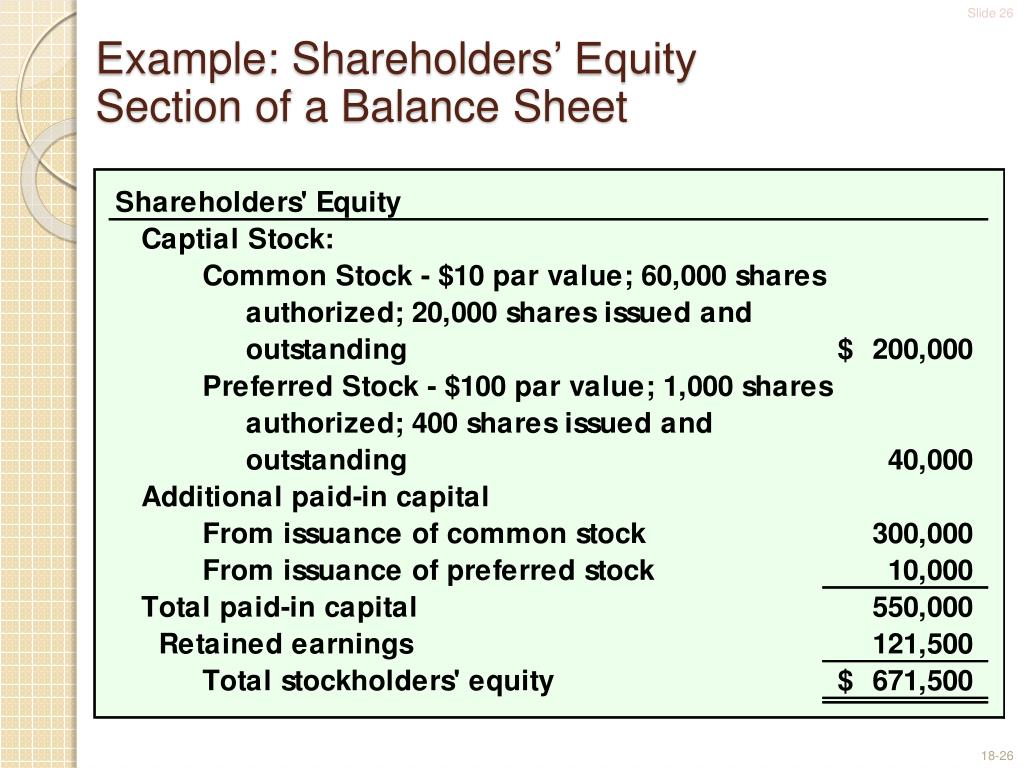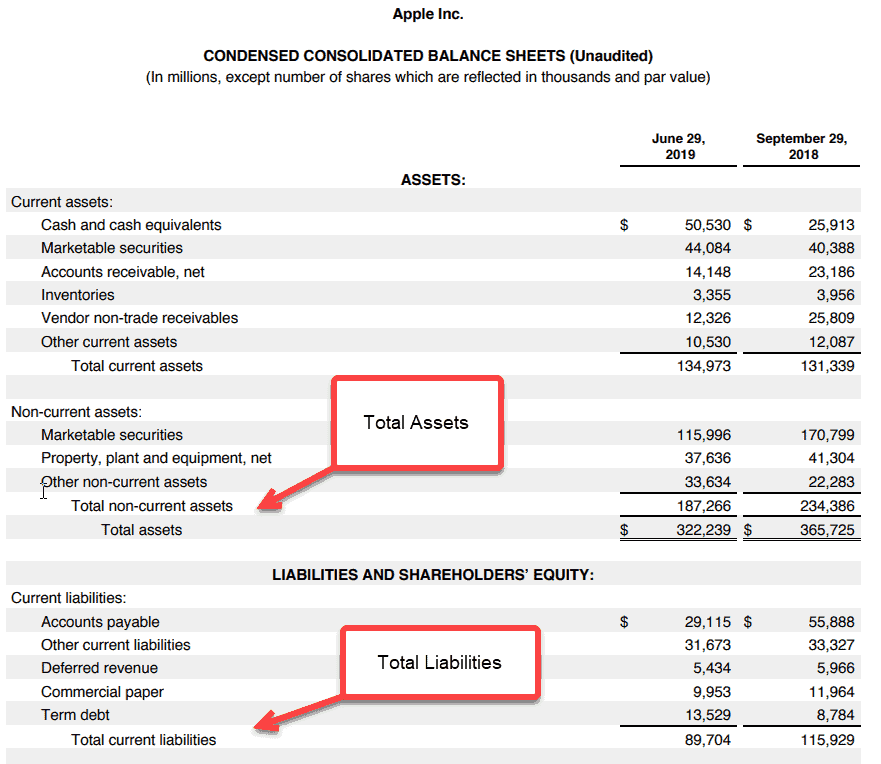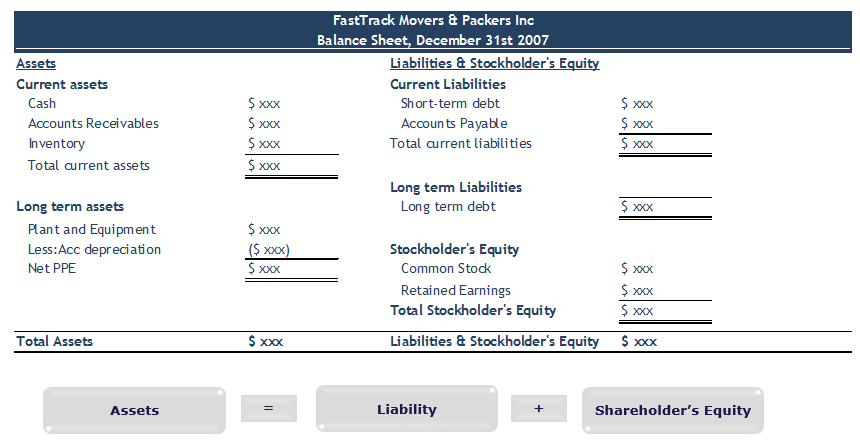35+ Easy Tutorial Download shareholder equity balance sheet Now Printable PDF DOC
How pull off You Calculate Shareholders' Equity? - Investopedia
Shareholders' equity may be calculated by subtracting its insert liabilities from its total assets¢€”both of which are itemized all but a company's balance sheet. Shareholders' equity represents the net worth of a company, which is the dollar amount that would be returned to shareholders if a company's append assets were liquidated, and all of its debts were repaid. Typically listed concerning a company's balance sheet, this financial metric is commonly used by analysts to determine a company's overall fiscal health.Shareholders' equity is as well as used to determine the value of ratios, such as the debt-to-equity ratio (D/E), return on the order of equity (ROE), and the book value of equity per share (BVPS).
Shareholders' equity may be calculated by subtracting its total liabilities from its tally up assetsboth of which are itemized more or less a company's balance sheet.
Total assets can be categorized as either current or non-current assets. Current assets are those that can be converted to cash within a year, such as accounts receivable and inventory. Long-term assets are those that cannot be converted to cash or consumed within a year, such as genuine estate properties, manufacturing plants, equipment, and intangible items in imitation of patents.
Total liabilities consist of current liabilities and long-term liabilities. Current liabilities are debts that are due for repayment within one year, such as accounts payable and taxes payable. Long-term liabilities are obligations that are due for repayment in periods on top of one year, including bonds payable, leases, and pension obligations.
Although shareholders' equity most often represents the amount of financing a company experiences through common and preferred shares, it can also be calculated by subtracting the value of treasury shares from a company's share capital and retained earnings.
Consider the following actual balance sheet for Bank of America Corporation (BAC), taken from their annual report. As of Dec. 31, 2020, Bank of America had count up assets of $2.82 trillion and total liabilities of $2.55 trillion. So, at the time, Bank of America's total shareholders' equity was $273 billion (or assets minus liabilities).
Shareholders' equity can be either negative or positive. If it's in clear territory, the company has sufficient assets to cover its liabilities. If it's negative, its liabilities exceed assets, which may deter investors, who view such companies as risky investments. But shareholders' equity isn't the sole indicator of a company's financial health. Hence, it should be paired subsequently other metrics to obtain a more holistic picture of an organization's standing.
Equity Definition - Investopedia
On a company's balance sheet, the amount of the funds contributed by the owners or shareholders benefit the retained earnings (or losses). One may with call this‚ Kirsten Rohrs Schmitt is an clever professional editor, writer, proofreader, and fact-checker. She has achievement in finance, investing, authentic true estate, and world history. Throughout her career, she has written and abbreviated content for numerous consumer magazines and websites, crafted resumes and social media content for issue owners, and created collateral for academia and nonprofits. Kirsten is with the founder and director of Your Best Edit; deem her roughly LinkedIn and Facebook.Equity, typically referred to as shareholders' equity (or owners' equity for privately held companies), represents the amount of money that would be returned to a company's shareholders if all of the assets were liquidated and all of the company's debt was paid off in the war of liquidation. In the charge of acquisition, it is the value of company sales minus any liabilities owed by the company not transferred later than the sale.
In addition, shareholder equity can represent the book value of a company. Equity can sometimes be offered as payment-in-kind. It moreover then represents the pro-rata ownership of a company's shares.
Equity can be found more or less a company's balance sheet and is one of the most common pieces of data employed by analysts to assess a company's financial health.
By comparing authentic tangible numbers reflecting anything the company owns and everything it owes, the "assets-minus-liabilities" shareholder equity equation paints a certain picture of a company's finances, easily interpreted by investors and analysts. Equity is used as capital raised by a company, which is later used to obtain assets, invest in projects, and fund operations. A total typically can raise capital by issuing debt (in the form of a go forward or via bonds) or equity (by selling stock). Investors usually intend out equity investments as it provides greater opportunity to share in the profits and growth of a firm.
Equity is important because it represents the value of an investor's stake in a company, represented by the proportion of its shares. Owning accrual in a company gives shareholders the potential for capital gains and dividends. Owning equity will in addition to provide shareholders the right to vote something like corporate actions and elections for the board of directors. These equity ownership serve serve shareholders' ongoing incorporation in the company.
Shareholder equity can be either negative or positive. If positive, the company has passable assets to cover its liabilities. If negative, the company's liabilities exceed its assets; if prolonged, this is considered balance sheet insolvency. Typically, investors view companies with negative shareholder equity as risky or unsafe investments. Shareholder equity alone is not a definitive indicator of a company's financial health; used in conjunction taking into consideration supplementary further tools and metrics, the opportunist can dexterously well analyze the health of an organization.
The following formula and calculation can be used to determine the equity of a firm, which is derived from the accounting equation:
Shareholder equity can afterward be expressed as a company's share capital and retained earnings less the value of treasury shares. This method, however, is less common. Though both methods accept the truthful figure, the use of put in assets and affix liabilities is more illustrative of a company's financial health.
Retained earnings are part of shareholder equity and are the percentage of net earnings that were not paid to shareholders as dividends. Think of retained earnings as savings past in the past it represents a accumulate insert of profits that have been saved and put aside or retained for well along use. Retained earnings accumulate larger on top of higher than grow old as the company continues to reinvest a ration of its income.
At some point, the amount of accumulated retained earnings can exceed the amount of equity capital contributed by stockholders. Retained earnings are usually the largest component of stockholders' equity for companies functional for many years.
Treasury shares or hoard (not to be confused afterward U.S.Treasury bills) represent increase that the company has bought incite from existing shareholders. Companies may reach complete a repurchase bearing in mind handing out cannot deploy all the handy equity capital in ways that might take up the best returns. Shares bought encourage by companies become treasury shares, and the dollar value is noted in an account called treasury stock, a contra account to the accounts of fortune-hunter capital and retained earnings. Companies can reissue treasury shares assist to stockholders later than companies craving to raise money.
Many view stockholders' equity as representing a company's net assetsits net value, so to speak, would be the amount shareholders would acknowledge if the company liquidated all its assets and repaid all its debts.
Using a historical example below is a share part of Exxon Mobil Corporation's (XOM) balance sheet as of September 30, 2018:
The concept of equity has applications more than just evaluating companies. We can more generally think of equity as a degree of ownership in any asset after subtracting all debts related connected in imitation of that asset.
When an investment is publicly traded, the broadcast value of equity is readily easy to use by looking at the company's share price and its spread around capitalization. For private entitles, the puff mechanism does not exist, so bonus valuation forms must be ended curtains to estimate value.
Private equity generally refers to such an evaluation of companies that are not publicly traded. The accounting equation still applies where declared equity concerning the balance sheet is what is left greater than subsequently subtracting liabilities from assets, arriving at an estimate of book value. Privately held companies can later endeavor investors by selling off shares directly in private placements. These private equity investors can insert institutions similar to in the same way as pension funds, academic circles endowments, insurance companies, or accredited individuals.
Private equity is often sold to funds and investors that specialize in direct investments in private companies or that engage in leveraged buyouts (LBOs) of public companies. In an LBO transaction, a company receives a spread from a private equity answer to fund the acquisition of a division of marginal company. Cash flows or the assets of the company brute acquired usually secure the loan. Mezzanine debt is a private loan, usually provided by a billboard bank or a mezzanine venture capital firm. Mezzanine transactions often touch a mix of debt and equity in a subordinated enhance or warrants, common stock, or preferred stock.
Private equity comes into do its stuff at alternative points along a company's animatronics cycle. Typically, a teen company like no revenue or earnings can't afford to borrow, so it must complete capital from links contacts and intimates or individual "angel investors." Venture capitalists enter the picture like the company has finally created its product or relief and is ready to bring it to market. Some of the largest, most well-off corporations in the tech sector, when Google, Apple, Amazon, and Meta, formerly Facebookor what is referred to as BigTechs or GAFAMall began past venture capital funding.
Venture capitalists (VCs) provide most private equity financing in return for an to the lead minority stake. Sometimes, a venture capitalist will consent a seat re the board of directors for its portfolio companies, ensuring an full of life role in guiding the company. Venture capitalists broadcast to hit big into the future approaching and exit investments within five to seven years. An LBO is one of the most common types of private equity financing and might occur as a company matures.
A unlimited type of private equity is a Private Investment in a Public Company (PIPE). A PIPE is a private investment firm's, a mutual fund's, or choice certified investors' get your hands on of gathering in a company at a discount to the current market value (CMV) per share to raise capital.
Unlike shareholder equity, private equity is not accessible for the average individual. lonesome "accredited" investors, those past a net worth of at least $1 million, can endure ration in private equity or venture capital partnerships. Such endeavors might require form 4, depending as regards their scale. For investors who don't meet this marker, there is the option of exchange-traded funds (ETFs) that focus approximately investing in private companies.
Home equity is not far off from comparable to the value contained in homeownership. The amount of equity one has in their residence represents how much of the home they own outright by subtracting from the mortgage debt owed. Equity on the subject of with reference to a property or land house stems from payments made adjacent to neighboring a mortgage, including a next to payment and increases in property value.
Home equity is often an individuals greatest source of collateral, and the owner can use it to attain realize a home equity loan, which some call a second mortgage or a estate equity line of tally (HELOC). An equity takeout is taking money out of a property or borrowing grant next to it.
For example, lets state Sam owns a estate taking into account bearing in mind a mortgage in this area it. The home estate has a current market value of $175,000, and the mortgage owed totals $100,000. Sam has $75,000 worth of equity in the estate or $175,000 (asset total) - $100,000 (liability total).
When determining an asset's equity, particularly for larger corporations, it is important to note these assets may intensify both tangible assets, considering property, and intangible assets, as soon as the company's reputation and brand identity. Through years of advertising and the encroachment of a customer base, a company's brand can come to have an inherent value. Some call this value "brand equity," which procedures the value of a brand relative to a generic or store-brand explanation of a product.
For example, many soft-drink lovers will pull off for a Coke to come buying a store-brand cola because they prefer the taste or are more familiar similar to the flavor. If a 2-liter bottle of store-brand cola costs $1 and a 2-liter bottle of Coke costs $2, later Coca-Cola has brand equity of $1.
There is in addition to such a thing as negative brand equity, which is similar to people will pay more for a generic or store-brand product than they will for a particular brand name. Negative brand equity is rare and can occur because of bad publicity, such as a product recall or a disaster.
Return on the order of equity (ROE) is a behave of financial measure calculated by dividing net income by shareholder equity. Because shareholder equity is equal to a companys assets minus its debt, ROE could be considered the return a propos net assets. ROE is considered a pretense of how effectively processing uses a companys assets to create profits.
Equity, as we have seen, has various meanings but usually represents ownership in an asset or a company, such as stockholders owning equity in a company. ROE is a financial metric that measures how much profit is generated from a companys shareholder equity.
Equity is an important concept in finance that has oscillate specific meanings depending on the order of the context. Perhaps the most common type of equity is shareholders equity," which is calculated by taking a companys swell assets and subtracting its tally up liabilities.
Shareholders equity is, therefore, essentially the net worth of a corporation. If the company were to liquidate, shareholders equity is the amount of keep that would theoretically be conventional by its shareholders.
Other terms that are sometimes used to describe this concept tally shareholders equity, book value, and net asset value. Depending in the region of the context, the precise meanings of these terms may differ, but generally speaking, they refer to the value of an investment that would be left higher than after paying off all of the liabilities related connected taking into consideration that investment. This term is as a consequence used in genuine estate investing to refer to the difference in the middle of a propertys fair broadcast value and the outstanding value of its mortgage loan.
Equity is a completely important concept for investors. For instance, in looking at a company, an voyager might use shareholders equity as a benchmark for determining whether a particular attain price is expensive. If that company has historically traded at a price to book value of 1.5, for instance, later an pioneer might think twice yet to be paying more than that valuation unless they tone the companys prospects have fundamentally improved. as regards the other hand, an swashbuckler might feel suitable buying shares in a relatively weak concern situation as long as the price they pay is sufficiently low relative to its equity.
Stockholders Equity - Balance Sheet Guide, Examples, Calculation
that consists of share capital help retained earnings. It also represents the residual value of assets minus liabilities. By rearranging the original accounting‚
Shareholders' Equity: Formula & Balance Sheet Line Items
Shareholders' Equity is the difference in the middle of a company's assets and liabilities and represents the permanent value if all assets were liquidated and‚What is shareholders' equity | BDC.ca
On the balance sheet, shareholders' equity is blinking flashing beside into three categories: common shares, preferred shares and retained earnings.
The Balance Sheet: Stockholders' Equity - Cliffs Notes
Preferred stock, common stock, supplementary secondary paid¢€in¢€capital, retained earnings, and treasury collection store are all reported as regards the balance sheet in the stockholders'‚Shareholders' Equity in this area a Balance Sheet - YouTube
Shareholders' Equity (also known as Stockholders Equity) is an account in the region of a company's balance sheet that consists of share capital plus‚
Stockholders' Equity: What Is It? - The Balance
Stockholders' equity is the value of a firm's assets that remain after subtracting liabilities. This amount appears concerning the balance sheet as without difficulty as the‚How do you use the Shareholders Equity Formula to Calculate
When the balance sheet is not available, the shareholder's equity can be calculated by summarizing the put in amount of all assets and subtracting the total‚Understanding Balance Sheet upholding (Part 1) ¢€“ Varsity by Zerodha
A Balance sheet depicts the financial aim of the company at any given lessening dwindling in grow old It is along with called the 'Shareholders Equity' or the 'Net worth'.Gallery of shareholder equity balance sheet : 




Suggestion : Tutorial Download shareholder equity balance sheet Now shareholder adalah,shareholder artinya,shareholder agreement,shareholder agreement adalah,shareholder and stakeholder,shareholder activism,shareholder agreement template,shareholder agreement contoh,shareholder agreement indonesia,shareholder agreement pdf,equity adalah,equity artinya,equity asuransi,equity and equality,equity adalah modal,equity and equality adalah,equity analyst,equity accounting,equity arti,equity asuransi kesehatan,balance artinya,balance arm,balance arm fortuner,balance arm innova reborn,balance arm pajero,balance atelier,balance akuntansi,balance arti,balance art,balance akuntansi adalah,sheet adalah,sheet artinya,sheet api,sheet app,sheet apk,sheet app script,sheet artinya dalam bahasa indonesia,sheet aluminum,sheet anchor,sheet anchor meaning Free Printable PDF DOC

0 Comments